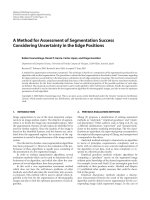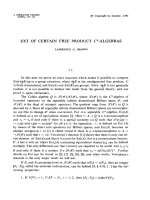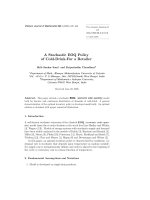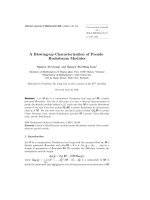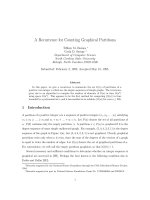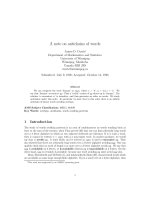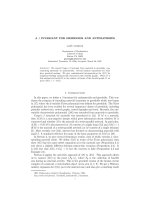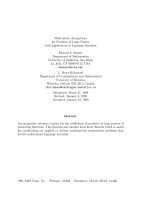Báo cáo toán học: " a construction for sets of integers with distinct subset sums" potx
Bạn đang xem bản rút gọn của tài liệu. Xem và tải ngay bản đầy đủ của tài liệu tại đây (124.69 KB, 14 trang )
a construction for sets of integers
with distinct subset sums
Tom Bohman
Department of Mathematics, 2-339
Massachusetts Institute of Technology
77 Massachusetts Ave.
Cambridge, MA 02139
Submitted: September 9, 1997; Accepted: November 24, 1997.
Abstract
A set S of positive integers has distinct subset sums if there are 2
|S|
dis-
tinct elements of the set
x∈X
x : X ⊂ S
. Let f (n) = min{max S : |S| =
n and S has distinct subset sums}. Erd˝os conjectured f(n) ≥ c2
n
for some
constant c. We give a construction that yields f(n) < 0.22002 ·2
n
for n suffi-
ciently large. This now stands as the best known upper bound on f(n).
1 Introduction
A set S of positive integers has distinct subset sums if the set
x∈X
x : X ⊂ S
has
2
|S|
distinct elements. Let
f(n) = min{max S : |S| = n and S has distinct subset sums}.
By taking the set S to be the first n powers of 2 we see that f(n) ≤ 2
n−1
. Some small
examples (the sets {3,5,6,7} and {6,9,11,12,13} for example) suggest that f(n) could
be much smaller than 2
n−1
. In 1931 Erd˝os conjectured that this is not the case [E1].
In particular, he conjectured that f(n) ≥ c2
n
for some constant c, and he offered $500
for settling this conjecture [E1] [G1] [G2].
In 1955 Erd˝os and Moser proved that f(n) ≥ 2
n
/(4
√
n) [E2] (for a proof using the
second moment method see [AS, p47]). This remains, up to the constant, the best
known lower bound (for an improvement in the constant see [Elk]).
The only improvements on the trivial upper bound on f(n) have been by con-
struction. A method often used for proving upper bounds is to verify that some set of
1991 Mathematics Subject Classification. Primary 11P99; Secondary 05D10.
the electronic journal of combinatorics 5(1998), #R3 2
i integers (where i is relatively small) has distinct subset sums and gives f(i) <c2
i
.
This then gives the bound f (j) <c2
j
for all j>iby the following observation: given
a set S with distinct subset sums, n elements and largest element m we construct a
set S
with distinct subset sums, n + 1 elements and largest element 2m by doubling
every element in S and introducing an odd number. The first upper bound on f(n)
that was found using this method was given by the Conway–Guy sequence. This
is a sequence of sets of integers that John Conway and Richard Guy constructed in
1967. They showed that the first 40 sets from this sequence have distinct subset
sums. The 40
th
set gives f(n) <.23513 ·2
n
for n ≥ 40 [G1] [G2] [CG]. This stood as
the best upper bound on f(n) until the mid 1980’s when Fred Lunnon conducted a
computational investigation of this problem. Lunnon found four sequences of sets of
integers that beat the Conway-Guy sequence. He verified that the first 67 sets from
each of these sequences have distinct subset sums. The 67
th
set from the best of these
sequences gives f(n) <.22096 · 2
n
for n ≥ 67 [L]. We should note that these aren’t
the only known constructions for a set of n integers with distinct subset sums and
largest element smaller than the trivial 2
n−1
, but they are the constructions that give
the best bounds on f(n) (for some other constructions see [L],[M] and [ANS]).
In this paper we construct a family of sequences of sets of integers which contains
all five of the sequences mentioned above. We go on to prove that all sets from each
of the sequences have distinct subset sums. We should note that a proof that the sets
from the Conway–Guy sequence have distinct subset sums as well as a brief account
of the general construction that is studied in detail here are given in [B].
This paper is organized as follows. The remainder of this section is a brief discus-
sion of the method introduced in [B] and used here to show that a set has distinct
subset sums. Section 2 contains the construction. In Section 3 we prove that the sets
constructed in Section 2 have distinct subset sums. Section 4 is an analysis of the
best upper bound on f(n) that can be achieved with this new construction.
Let S = {a
1
>a
2
> >a
n
}be an arbitrary set of p ositive integers (note that
we take these in the opposite of their natural order). We will now outline a method
for proving S has distinct subset sums. We begin by considering a condition which
is equivalent to the distinct subset sums condition. Note that S fails to have distinct
subset sums if and only if there are disjoint I,J ⊂ S with
I =
J (for a set
of integers X we write
X for
x∈X
x) . This is equivalent to a condition on
the differences between the integers in our set. We form the difference vector of
S : d
S
=(a
1
−a
2
,a
2
−a
3
, , a
n−1
− a
n
,a
n
). The condition on the differences is
determined by changing the order of summation in the distinct sums condition on
subsets of S. To state the condition precisely we need the following definition: an
n–dimensional vector v with integer–valued components will be called smooth if
|v(1)|≤1 and |v(i) − v(i +1)|≤1 for i =1, , n − 1.
Lemma 1.1. Let S be a set of n positive integers. There exists I,J ⊂ S such that
I ∩J = ∅ and
I =
J ⇐⇒ there exists a nonzero, smooth, n–dimensional vector
v such that v ·d
S
=0
the electronic journal of combinatorics 5(1998), #R3 3
Proof. (⇒) Let I = {y
1
,y
2
, , y
k
},J ={z
1
,z
2
, , z
l
}, and suppose
I =
J, i.e.
k
i=1
y
i
−
l
i=1
z
i
=0.
For appropriate choices of α
i
and β
i
,wehave:
y
i
=
n
j=α
i
d
S
(j) z
i
=
n
j=β
i
d
S
(j).
Notice that the α
i
s and β
i
s are all distinct. We can write:
k
i=1
n
j=α
i
d
S
(j) −
l
i=1
n
j=β
i
d
S
(j)=0.
In order to reverse the order of summation we must count how many times each d
S
(j)
appears in this summation. This is achieved by setting:
v(j)=|{i : α
i
≤ j ≤ n}|−|{i:β
i
≤j ≤n}|.
Then v ·d
S
is the sum on the left hand side of the above equation, and v is smooth
by the distinctness of the α
i
s and β
i
s.
(⇐) Any smooth vector can be written as the sum of ±1 multiples of characteristic
vectors of intervals that have right endpoints at n and distinct left endpoints. By
reversing the above process, we can see how such a set of characteristic vectors gives
us sets I and J.
So, to show that S has distinct subset sums we must show that v · d
S
= 0 for
all nonzero smooth vectors v. Let v be a nonzero smooth vector. For the sets of
integers we consider there is a natural way to construct a sequence w
n
, w
n−1
, , w
2
of approximations of v that have the following two properties:
(i). w
i
agrees with v in the n − i + 1 coordinates where d
S
is greatest, and
(ii). w
i
· d
S
=0.
We will show (this is the key to the proof) that
(iii). If w
2
is nonzero then w
2
is not smooth.
This implies v · d
S
= 0 because w
2
agrees with v in exactly n − 1 coordinates and
w
2
· d
S
= 0. In the proof that follows we refine this approach by eliminating special
classes of v’s from consideration in the course of the argument.
Note that it is also the case that, for i =3, ,n,ifw
i
is nonzero then w
i
is not
smooth. This fact is implied by (iii) (to see this, argue by contradiction taking v to
be w
i
). In many cases this fact also follows from the proof given below as the proof
entails a detailed step by step analysis of w
n
, ,w
2
.
the electronic journal of combinatorics 5(1998), #R3 4
2 The construction
Let n, a parameter of our construction, be some integer greater than 1. We con-
struct an infinite dimensional difference vector d
n
. This gives a sequence of sets
S
n,2n
,S
n,2n+1
, (note that we start at a set with cardinality 2n) as follows:
S
n,m
=
m
j=i
d
n
(j):i=1, ,m
.
Clearly, the first m coordinates of d
n
form the difference vector of S
n,m
.
The vector d
n
is defined differently on two different intervals of coordinates. We
call these intervals of coordinates regions of definition. For 1 ≤ i ≤ 2n (the first
region of definition) we set
d
n
(i)=
1ifi=n
4
j−1
if i = n + j for 1 ≤ j ≤ n
2(4
j−1
)ifi=n−jfor 1 ≤ j ≤ n −1.
For i greater than 2n (the second region of definition), d
n
(i) is defined recursively; in
particular,
d
n
(i)=
i−1
j=i−b
n
(i)
d
n
(j) for i>2n.
To finish the construction, we define the recursive rule sequence b
n
:
b
n
(i)=
n+1 ifi=2n+1ori=2n+2
n+2 ifi=2n+3
2(i +2−2n)
for i ≥ 2n +4
where [·] is the nearest integer function. Thus, for example, we have
d
3
=(8,2,1,1,4,16, 22, 43, 86, 151, 302, ), and
S
3,6
= {32, 24, 22, 21, 20, 16}, ,
S
3,9
={183, 175, 173, 172, 171, 167, 151, 129, 86},
An important property of this construction is that for all i = n there exists an
interval I
i
of coordinates such that I
i
is adjacent to the i
th
coordinate and
d
n
(i)=
j∈I
i
d
n
(j). (1)
We can think of the n
th
coordinate as the starting point where we set d
n
(n)=1.
We can then think of the rest of d
n
as being build up recursively using I
n+i
=
[n −i +1,n+i−1] and I
n−i
=[n−i+1,n+i] on the first region of definition and
the electronic journal of combinatorics 5(1998), #R3 5
I
i
=[i−b
i
,i−1] on the second region of definition. The fact that each d
n
(i) can be
written as such a sum is what facilitates the use of the proof technique outlined in
the introduction.
Before going on we should also note an important property of the vector b
n
.
Clearly, the sequence b
n
(2n +4),b
n
(2n +5), is an increasing sequence of positive
integers. It happens that b
n
(2n + 4) = 3 and for k ≥ 4 the integer k appears exactly
k times in the sequence b
n
(2n +5),b
n
(2n +6), (this is easily verified from the
definition of b
n
). An important consequence of this (which is crucial for the proof
given in Section 3) is that
b
n
(k) > b
n
(k − b
n
(k)) for k>2n+7. (2)
We can now state the central result.
Theorem 2.1. If n and m are integers satisfying n ≥ 1 and m ≥ 2n then S
n,m
has
distinct subset sums.
There is also an alternate version of this construction. We begin with an integer
n>0 and construct an infinite dimensional difference vector d
n
in a fashion similar
to what is given above. First, for 1 ≤ i ≤ 2n + 1 we set
d
n
(i)=
1ifi=n+1
4
j−1
if i = n +1−j for 1 ≤ j ≤ n
2(4
j−1
)ifi=n+1+j for 1 ≤ j ≤ n.
Then we define our recursive rule vector b
n
:
b
n
(i)=
n+1 ifi=2n+2
n+2 ifi=2n+3ori=2n+4
2(i +1−2n)
for i ≥ 2n +5.
Finally, using b
n
, we finish the construction of d
n
:
d
n
(i)=
i−1
j=i−b
n
(i)
d
n
(j) for i>2n+1.
For example, we have
d
3
= (16, 4, 1, 1, 2, 8, 32, 43, 86, 171, 200, 400, ).
And, once again, we get a sequence of sets that correspond to this difference vector
by taking
S
n,m
=
m
j=i
d
n
(j):i=1, ,m
for m ≥ 2n +1.
These sets will also have distinct subset sums.
the electronic journal of combinatorics 5(1998), #R3 6
Theorem 2.2. If n and m are positive integers such that m ≥ 2n +1 then S
n,m
has
distinct subset sums.
As we stated in the introduction this family of sequences (taking all sequences
corresponding to either a d
n
or a d
n
to be one family of sequences) contains the
sequences given by Conway and Guy and Lunnon. In particular, d
1
is the difference
vector corresponding to the Conway–Guy sequence (for more on the Conway–Guy
sequence see [B] and [G1]), and d
2
, d
2
, d
3
, and d
3
are the difference vectors for the
sequences discovered by Lunnon.
No proof of Theorem 2.2 will be given because the proof of Theorem 2.2 is ex-
tremely similar to the proof of Theorem 2.1 given below.
3 Proof of Theorem 2.1
For ease of notation let d = d
n
and b = b
n
.Ifvis an m–dimensional vector then
we write v · d for the dot product of v with the first m coordinates of d. We prove
Theorem 2.1 by (as provided by Lemma 1.1) showing that no smooth m–dimensional
vector where m ≥ 2n dots with d to give zero. Preparatory to that discussion, we
develop some lemmas concerning d.
Lemma 3.1. If v is a smooth (2n −2)–dimensional vector with |v(2n −2)|≤1then
v ·d < d(2n).
Proof. Since v is smooth, v(i) ≤ i. Since v(2n − 2) ≤ 1 and v is smooth, v(i) ≤
2n −1 −i. So, v(i) ≤ min{i, 2n −1 −i}, and
v ·d ≤
2n−2
i=1
d(i) min{i, 2n −1 −i} =
n−1
i=1
2n−1−i
j=i
d(j)=
n−1
i=1
(d(i)+d(2n −i))
=
n−1
i=1
2 ·4
n−i−1
+4
n−i−1
=
n−1
i=1
4
n−i
− 4
n−i−1
=4
n−1
−4
0
=d(2n) −1.
Lemma 3.2. If i ≥ 2n −2 then
i
j=1
d(j) < d(i +2).
Proof. This follows from lemma 3.1 when i =2n−2. For larger i the proof follows
by induction:
d(i +2)=
i+1
j=i+2−b(i+2)
d(j) ≥ d(i)+d(i+1)>d(i)+
i−1
j=1
d(j).
Lemma 3.3. If v is a smooth i–dimensional vector where i ≥ 2n −2 and |v(i)|≤1
then v ·d < d(i +2)+d(i+3).
the electronic journal of combinatorics 5(1998), #R3 7
Proof. We go by induction. When i =2n−2 the result follows from lemma 3.1.
Suppose v is a smooth i–dimensional vector where i>2n−2 and |v(i)|≤1. Let
1 be the i–dimensional all 1’s vector. Define the vector z by z(j) = max{v(j) −1, 0}
for 1 ≤ j ≤ i − 1. Then z is a smooth vector with |z(i − 1)|≤1. Applying the
inductive hypothesis to z and Lemma 3.2 to 1 ·d yields
v ·d =(v−1)·d+1·d
≤z·d+1·d
<(d(i+1)+d(i+ 2)) + d(i +2)
≤d(i+3)+d(i+2).
Before we start the proof we also need to establish some definitions. Let σ be the
permutation of {1,2, ,2n}defined by
σ(i)=
n+i/2ifiis even
n −(i −1)/2ifiis o dd.
This is the permutation that orders the differences in the first region of definition
(note that we need no such permutation in the second region of definition as the
differences are in ascending order). In other words, σ is the permutation for which
σ(1) = n and, for 2 ≤ i, j ≤ 2n, d(σ(i)) < d(σ(j)) ⇐⇒ i<j.
We now define a set of vectors. These vectors are defined differently on the two
regions of definition. For 2 ≤ i ≤ 2n let
x
i
(j)=
1ifσ(i)=j
−1ifj=σ(l) for some l<i
0 otherwise,
and for i>2nlet
x
i
(j)=
1ifi=j
−1ifi−b(i)≤j≤i−1
0 otherwise.
Note that x
1
is not defined. Also note that, due to (1), x
i
·d = 0 for i ∈{2, ,m}.
We are now ready to begin the proof. Let v be a smooth nonzero vector of di-
mension m where m ≥ 2n. As outlined in the introduction, we construct a sequence,
w
m
, w
m−1
, ,w
2
, of approximations to v. Our goal is to show that these approxi-
mations satisfy
(i). w
i
agrees with v in the m − i + 1 coordinates where d is greatest,
(ii). w
i
· d = 0, and
(iii). If w
2
is nonzero then w
2
is not smooth.
the electronic journal of combinatorics 5(1998), #R3 8
To define the approximations, first set ρ
m
= v(m) and w
m
= ρ
m
x
m
. Once w
i+1
is
determined let
ρ
i
=
v(i) −w
i+1
(i)if2n+1≤i≤m−1
v(σ(i)) − w
i+1
(σ(i)) if 2 ≤ i ≤ 2n.
and set w
i
= w
i+1
+ ρ
i
x
i
. Since each w
i
is a linear combination of the x
i
’s, property
(ii) holds. Property (i) is also immediate.
It remains to show that w
2
is not smooth. Before doing this we establish two
important properties of the sequence ρ
m
,ρ
m−1
, ,ρ
2
. These properties follow from
the smoothness of v, and we have one property for each region of definition of d.
Lemma 3.4. If ρ
m
> 0 then ρ
j
> 0 for max{2n, m − b(m)}≤j≤m−1.
Proof. Suppose inductively that ρ
j+1
, ,ρ
m−1
>0. Then, using j ≥ m −b(m)
w
j+1
(j)=−
m
i=j+1
ρ
i
≤−m+j.
Since ρ
m
> 0, we have v(m) > 0. Since v is smooth, it follows from v(m) > 0 that
v(j) ≥ 1 −m + j. Therefore, ρ
j
= v(j) −w
j+1
(j) ≥ 1 − m + j − (−m + j)=1.
Lemma 3.5. For j = max{i ≤ 2n : ρ
i
=0},
ρ
j
ρ
j−2
,ρ
j
ρ
j−4
, >0 and ρ
j
ρ
j−1
,ρ
j
ρ
j−3
, ≥0.
Proof. Without loss of generality, assume ρ
j
> 0. Also assume σ(j) >n; the proof
for σ(j) <nis nearly identical to what follows.
We consider inductively ρ
j−i
for i =1, ,j−2. Of course, in order to prove the
Lemma we must show
ρ
j−i
≥ 0ifiis odd, and
ρ
j−i
> 0ifiis even.
(3)
We begin by showing ρ
j−1
≥ 0. Unfortunately, this must be done in two cases:
j =2nand j<2n.Ifj=2nthen w
2n
(σ(2n − 1)) = w
2n
(1) = −ρ
2n
≤−1. By
the definition of a smooth vector we have v(1) ≥−1. Hence v(1) ≥ w
2n
(1), and
ρ
2n−1
≥ 0. If j<2nthen v(σ(j + 1)) = w
j
(σ(j + 1)) = 0. The smoothness of v
between coordinates σ(j + 1) and σ(j +1)+1=σ(j−1) implies v(σ(i − 1)) ≥−1.
Since w
j
(σ(j −1)) = −ρ
j
≤−1, it follows that ρ
j−1
≥ 0.
Now, suppose (3) holds for i =1, ,k where k is odd. Let M = ρ
2n+1
+ ρ
2n+2
+
ρ
2n+3
and L =
k−2
i=0
ρ
j−i
.Now,
v(σ(j−k+ 1)) = w
j−k+1
(σ(j −k + 1)) = −M −L + ρ
j−k+1
, and
w
j−k
(σ(j −k − 1)) = −M −L −ρ
j−k+1
− ρ
j−k
.
Since v is smooth and σ(j −k +1)−1=σ(j−k−1),
v(σ(j − k −1)) ≥−M−L+ρ
j−k+1
− 1.
the electronic journal of combinatorics 5(1998), #R3 9
Thus,
ρ
j−k−1
= v(σ(j −k − 1)) − w
j−k
(σ(j −k − 1))
≥ 2ρ
j−k+1
+ ρ
j−k
− 1
≥ 1.
(4)
Simillarly,
v(σ(j − k)) = w
j−k
(σ(j −k)) = −L −ρ
j−k+1
+ ρ
j−k
, and
w
j−k−1
(σ(j −k − 2)) = −L − ρ
j−k+1
− ρ
j−k
− ρ
j−k−1
.
Since σ(j − k)+1=σ(j−k−2) and v is smooth,
v(σ(j − k −2)) ≥−L−ρ
j−k+1
+ ρ
j−k
− 1.
It then follows from (4) that
ρ
j−k−2
= v(σ(j −k − 2)) − w
j−k−1
(σ(j −k − 2))
≥ 2ρ
j−k
+ ρ
j−k−1
− 1
≥ 0.
An important implication of Lemma 3.5–we will apply this in showing that w
2
is not
smooth–is
ρ
2
ρ
3
≥ 0. (5)
We now divide the argument into cases based on the dimension of v and the
sequence of ρ
i
’s. This argument is inductive; for all cases after Case 1 we are assuming
that no smooth vector of smaller dimension dots with d to give zero (this assumption
is only used in Case 4). Throughout these cases we assume without loss of generality
that v(m) > 0 and hence ρ
m
> 0.
CASE 1. m =2n.
Since v is nonzero there exists j such that ρ
j
= 0. Lemma 3.5 then implies that
either ρ
2
=0orρ
3
=0.
Suppose ρ
2
= 0. Let M =
2n
i=3
ρ
i
. Then w
2
(n)=−M−ρ
2
while w
2
(n +1)=
−M+ρ
2
. Hence, w
2
is not smooth.
Suppose ρ
2
= 0 and hence ρ
3
= 0. Let M =
2n
i=4
ρ
i
. Then w
2
(n)=−M−ρ
3
while w
2
(n −1) = −M + ρ
3
. Hence, w
2
is not smooth.
CASE 2. 2n +1≤m≤2n+3.
By Lemma 3.4, ρ
j
> 0 for 2n ≤ j ≤ m − 1. Lemma 3.5 then implies that
ρ
2
> 0 and ρ
3
≥ 0. Let M =
2n
i=4
ρ
i
. Then w
2
(n − 1) = −M + ρ
3
while w
2
(n)=
−M−ρ
3
−ρ
2
−ρ
2n+1
. Therefore w
2
(n −1) −w
2
(n)=2ρ
3
+ρ
2
+ρ
2n+1
≥ 2, and w
2
is not smooth.
the electronic journal of combinatorics 5(1998), #R3 10
CASE 3. m ≥ 2n +4and ρ
2n+1
, ρ
m−1
> 0.
Let M =
2n
i=4
ρ
i
. Then w
2
(n−1) = −M +ρ
3
, w
2
(n)=−M−ρ
3
−ρ
2
−ρ
2n+1
, and
w
2
(n+1) = −M−ρ
3
+ρ
2
−ρ
2n+1
−ρ
2n+2
−ρ
2n+3
.Ifρ
2
≤0 then w
2
(n)−w
2
(n+1) =
−2ρ
2
+ ρ
2n+2
+ ρ
2n+3
≥ 2 and w
2
is not smooth. On the other hand, if ρ
2
> 0 then
(5) implies ρ
3
≥ 0. In this case w
2
(n −1) −w
2
(n)=2ρ
3
+ρ
2
+ρ
2n+1
≥ 2 and w
2
is
not smooth.
CASE 4. m ≥ 2n +4and ∃t ≥ 2n +4such that ρ
t−1
≤ 0 while ρ
t
, , ρ
m−1
> 0.
We begin by investigating the structure of w
t
. By property (i) of w
t
, we have
w
t
(i)=v(i) for i ≥ t. It is also clear from the definition of w
t
that w
t
(i)=0for
i<t−b(t). So, the interesting part of w
t
is in coordinates i where t−b(t) ≤ i ≤ t−1.
Set c(k) = max{l : l − b(l) ≤ k}. Then for t − b(t) ≤ i ≤ t − 1wehave
w
t
(i)=−
c(i)
j=t
ρ
j
.
Since c(k) is strictly increasing, w
t
(t − b(t)), , w
t
(t − 2), w
t
(t − 1) is a strictly
decreasing sequence of negative numbers. We will show that
∃ t −b(t) −1 ≤ s ≤ t −2 such that c(s +1)=c(s)+2andc(s+1)≥t+1,
whence w
t
(s+1) ≤w
t
(s)−2 (i.e there is a ‘double jump in w
t
between co ordinates s
and s+1). The existence of such an s comes from the rule by which we constructed b.
Let y = c(t−1). Note that Lemma 3.4 implies y<m. Since y +1−b(y+1) >t−1we
have b(y+1) = b(y). Applying (2) we get b(t)=b(y+1−b(y+1)) < b(y+1) = b(y).
It follows that there exists u with t ≤ u<yand b(u +1) = b(u) + 1. Then
s = u −b(u) −1 has the desired properties.
Consider the vector z = v −w
t
. Property (ii) of w
t
implies
v ·d = z ·d.
Property (i) of w
t
implies z(i)=0fori≥t. Since we’re assuming ρ
t−1
≤ 0, we have
w
t
(t − 1) ≥ v(t − 1). Since w
t
(t − b(t) − 1), w
t
(t − b(t)), , w
t
(t − 2), w
t
(t − 1) is
strictly decreasing and v is smooth, we have w
t
(i) ≥ v(i) for t −b(t) −1 ≤ i ≤ t −1.
Furthermore, the existence of the double jump between w
t
(s) and w
t
(s + 1) implies
that w
t
(i) > v(i) for t −b(t) −1 ≤ i ≤ s. Thus,
z(i)
=0 ifi≥t
≤0ifs+1≤i≤t−1
<0ift−b(t)−1≤i≤s,
(6)
and
(z(1), z(2), ,z(t−b(t)−1)) is a smooth vector. (7)
We now consider cases.
the electronic journal of combinatorics 5(1998), #R3 11
Subcase 4.1. z(i) < 0 for i ≤ s.
Clearly, 0 > z ·d = v · d.
For the remaining two cases let q = max{i<t−b(t)−1: z(i)=0}. When we
restrict z to its first q − 1 components (which are also the first q − 1 components of
v) we get a smooth vector y with |y(q − 1)|≤1.
Subcase 4.2. There exists r>q+1such that z(r) < 0.
Since t ≥ 2n +4,t−b(t)−1≥2n. So, if q<2nthen z(2n) < 0. In this case we
apply Lemma 3.1 to y to get
0 > y ·d −d(2n) ≥ z · d = v ·d.
On the other hand, if q ≥ 2n we apply Lemma 3.3 to y to get
0 > y ·d −d(q +1)−d(q+2)≥y·d−d(q+1)−d(r)≥z·d=v·d.
Subcase 4.3. For al l r>q+1, z(r)=0.
It follows from (6) that s = q +1 = t−b(t)−1. Furthermore, z(i)=0for
i>t−b(t)−1, and hence v ·d = z ·d =(z(1), ,z(t−b(t)−1)) ·d. However, by
(7) and our inductive hypothesis, we have (z(1), ,z(t−b(t)−1)) ·d =0.
CASE 5. m ≥ 2n +4and ρ
2n+3
, , ρ
m−1
> 0, but either ρ
2n+1
≤ 0 or ρ
2n+2
≤ 0.
Suppose ρ
2n+2
≤ 0. Note that, by Lemma 3.4, this implies m ≥ 2n + 7. We begin
with a description of w
2n+3
. Clearly,
w
2n+3
(i)=
−ρ
2n+3
− ρ
2n+4
− ρ
2n+5
− ρ
2n+6
if i =2n+2
−ρ
2n+3
− ρ
2n+4
− ρ
2n+5
if i =2n+1
−ρ
2n+3
if n +1≤i≤2n
0if1≤i≤n.
Since ρ
2n+2
≤ 0 and v is smooth we have
v(i) ≤
w
2n+3
(i)ifi=2n+1,2n+2
min{i, 2n −1 −ρ
2n+3
− i} if 1 ≤ i ≤ 2n.
So, for z := v − w
2n+3
,
z(i) ≤ y(i):=
0ifi=2n+1,2n+2
min{i, 2n −1 −i} if 1 ≤ i ≤ 2n.
Note that the restriction of z to its first 2n coordinates is not necessarily smooth as
w
2n+3
(n +1)=−ρ
2n+3
while w
2n+3
(n) = 0. However, the restriction y to its first 2n
coordinates is smooth, and, therefore, it follows from Lemma 3.1 that y · d < 0. It
then follows from properties (i) and (ii) of w
2n+3
that v ·d = z ·d ≤ y ·d < 0.
The proof is similar if ρ
2n+2
> 0 and ρ
2n+1
≤ 0.
the electronic journal of combinatorics 5(1998), #R3 12
4 Calculating the new upper bound
Our first step is to construct the sequence of greatest elements of the given sequence
of sets of integers. Let v
n
(k) = max S
2n,k
. A direct calculation yields:
v
n
(2n)=(1/2)2
2n
,
v
n
(2n +1)=2/3+(5/12)2
2n+1
,
v
n
(2n +2)=1+(3/8)2
2n+2
,
v
n
(2n +3)=5/3 + (17/48)2
2n+3
and
v
n
(k +1)=2v
n
(k)−v
n
(k−b
n
(k+ 1)) for k ≥ 2n +3.
Let r
n
(k)=v
n
(k)/2
k
. Our goal is too find the minimum over k of r
n
(k). The
values of v
n
listed above imply
r
n
(2n)=1/2,
r
n
(2n +1)=5/12+(1/3)2
−2n
,
r
n
(2n +2)=3/8+2
−2n−2
,
r
n
(2n +3)=17/48+(5/3)2
−2n−3
and
r
n
(k +1)=r
n
(k)−r
n
(k−b
n
(k+ 1))/2
1+b
n
(k+1)
for k ≥ 2n +3.
Since v
n
(k) and hence r
n
(k) is positive, the sequence {r
n
(k)}
∞
k=2n
is decreasing. In
order to find the best upper bound on f(n) that can be obtained from the difference
vector d
n
we must calculate the limit as k tends to infinity of r
n
(k).
We will not calculate this limit directly for all n. As it happens that this limit
decreases as n increases, we consider the limit of these sequences. In particular,
consider the sequence
r(3)=1/2,
r(4)=5/12,
r(5)=3/8,
r(6)=17/48 and
r(k +1)=r(k)−r(k−b(k+ 1))/2
1+b(k+1)
for k ≥ 6.
where b is defined by b(i)=
2(i −1)
(which is also known as b
1
, the recursive
rule for the Conway–Guy sequence).
Claim 4.1. r(3 + k) ≤ r
n
(2n + k) ≤ r(3 + k)+(1/3)2
−2n
for k ≥ 0.
Proof. Let e be the vector defined by e(k)=r
n
(2n + k) − r(3 + k). For k ≥ 6we
have
e(k +1)=e(k)−e(k−b(k+ 1))/2
1+b(k+1)
.
The claim follows immediately from
e(k +1)>e(k)/2 for k ≥ 0, (8)
the electronic journal of combinatorics 5(1998), #R3 13
as (8) implies e(k) ≥ 0 for k ≥ 0. It is easy to see that (8) holds for k =0,1,2. For
k ≥ 3 we proceed by induction:
e(k +1)=e(k)−
e(k−b(k+ 1))
2
1+b(k+1)
> e(k) −
e(k) ·2
b(k+1)
2
1+b(k+1)
= e(k)/2.
(9)
It follows from Claim 4.1 that, for L := lim
k→∞
r(k), the limit as k goes to infinity
of r
n
(k)isbetweenLand L +(1/3)2
−2n
. An investigation of the sets generated by
d
n
reveals a similar convergence in their sequences of ratios to r. So, L is the best
upper bound on f(n) that is achieved with either of these constructions. The rest of
this section consists of the calculation of L.
We follow the argument given in [G1] to determine the asymptotic upper bound
on f(n) given by the Conway–Guy sequence. Let p
j
= j(j − 1)/2 + 1; that is,
p
j
is taken to be the last index for which b equals j − 1. We use r(p
j
) for some
sufficiently large j as an approximation of L. We now calculate the difference between
this estimate and subsequent terms in the sequence. By the definition of r we have
r(p
j
+1)=r(p
j
)−2
−j−1
r(p
j
−j). Iterating this observation we have
r(p
j+1
)=r(p
j
)−
p
j+1
−1
i=p
j
2
−j−1
r(i −j).
But, this also can be iterated to give
r(p
j+m
)=r(p
j
)−
m−1
k=0
2
−j−k−1
p
j+k+1
−1
i=p
j+k
r(i −j −k).
Since r is decreasing the terms in the inner summation are bounded between (if j is
sufficiently large) 3/8 and L. So, we can conclude that
r(p
j
) −3/8
m−1
k=0
2
−j−k−1
(j + k) < r(p
j+m
) < r(p
j
) −L
m−1
k=0
2
−j−k−1
(j + k).
A simple calculations shows that
m−1
k=0
2
−j−k−1
(j +k)=(j+1)/2
j
−(j+m+1)/2
j+m
.
If we let m tend to infinity the second term disappears and we get
r(p
j
) −
3(j +1)
(8)2
j
<L<r(p
j
)−
L(j+1)
2
j
. (10)
A simple computer calculation gives the approximation .2200188 < r(p
25
) <.2200189.
So, we can use the inequality on the left to get .2200185 <L. Plugging this back into
the inequality on the right gives L<.2200188. So, we can make an approximation
of L ≈ .22001865 with an error of less than 1.5 ·10
−7
. Inequality (10) can certainly
be used to obtain more precise approximations of L.
the electronic journal of combinatorics 5(1998), #R3 14
References
[AS] N. Alon and J. Spencer, The Probabilistic Method, Wiley, 1992.
[ANS] M.D. Atkinson, A. Negro and N. Santoro, Sums of Lexicographically Ordered
Sets. Discrete Math 80(1990) 115–122.
[B] T. Bohman, The Conway–Guy sequence and a sum packing problem of Erd˝os,
Proceedings Amer. Math. Soc., 124(1996) 3627–3636.
[CG] J.H. Conway and R.K. Guy, Sets of natural numbers with distinct subset sums,
Notices Amer. Math. Soc., 15(1968) 345.
[Elk] N. Elkies, An improved lower bound on the greatest element of a sum–distinct
set of fixed order, J. Comb. Th. A, 41(1986) 89-94.
[E1] P. Erd˝os, Personal communication.
[E2] P. Erd˝os, Problems and results from additive number theory, Colloq. Th´eorie
des nombres, Bruxells(1955) 127-137.
[G1] R.K. Guy, Sets of integers whose subsets have distinct sums, Ann. Discrete
Math., 12(1982) 141-154.
[G2] R.K. Guy, Unsolved Problems in Number Theory, Springer-Verlag, 1981.
[L] W.F. Lunnon, Integer sets with distinct subset sums, Math. Compute, 50(1988)
297-320.
[M] R. Maltby, Bigger and Better Subset–Sums–Distinct Sets, Mathematika, to ap-
pear.


